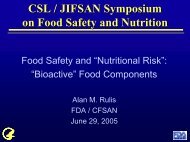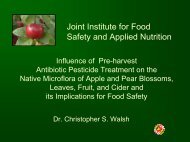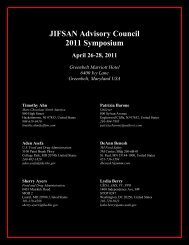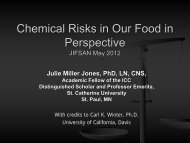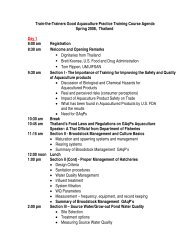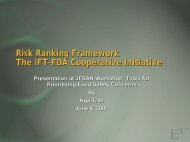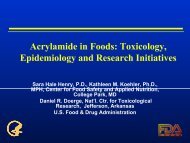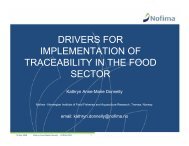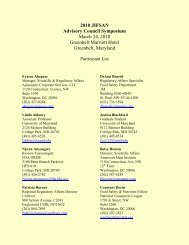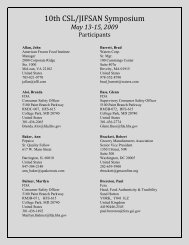PDF(186 KB) - jifsan
PDF(186 KB) - jifsan
PDF(186 KB) - jifsan
Create successful ePaper yourself
Turn your PDF publications into a flip-book with our unique Google optimized e-Paper software.
Working Group V: Risk Communication<br />
Questions surrounding risk communication were answered with input from participants<br />
floating to the other working groups. Questions to the working group and answers<br />
discussed are listed below<br />
1. Does the current science on acrylamide in food require any new focus on public<br />
communication What might be needed<br />
a. Provide context on current information<br />
b. Polish existing messages and update appropriately<br />
c. Keep it simple for consumers to understand<br />
2. What new findings presented at the workshop are of potential interest to the lay<br />
public<br />
a. Risk characterization<br />
b. Progress on mitigation – more needs to be done; potentially long term<br />
c. Potential strategies in the home to avoid over-browning of foods. The<br />
importance of time- temperature in heating. More research is needed.<br />
3. Do any findings present unique challenges for public communication<br />
a. No, but some general uncertainties may require forethought in future<br />
communication strategy<br />
4. Does a risk communication analysis indicate any adjustment to public<br />
communication needs<br />
a. Generally no, but . . . opportunities to strengthen global collaboration and<br />
information sharing exist<br />
b. Risk / Benefit messages need to be considered<br />
5. Is additional consumer attitude research necessary to gauge public awareness of<br />
concern about acrylamide in food Of the remaining research needs, which is the<br />
highest priority<br />
a. No additional consumer research is needed but it would be in our best<br />
interest to retain the option depending on trends in consumer awareness<br />
and media interest<br />
Working Group VI: Risk Characterization<br />
‣ Risk characterization can be defined as the convergence of risk identification, risk<br />
quantification and understanding uncertainties / knowledge gaps<br />
‣ Important for decision makers<br />
‣ “If we fix the acrylamide problem is it better or worse for consumers”<br />
‣ The risk of neurotoxicity is negligible<br />
‣ Challenges remain in identifying the most susceptible populations . . . other than<br />
age class<br />
‣ Context is important to describe the impact of uncertainty (this is what we’ve<br />
learned, this is what we still need to know); progress – uncertainty<br />
JIFSAN Acrylamide Workshop: Summary of Working Group 5 – Risk Communication 3





